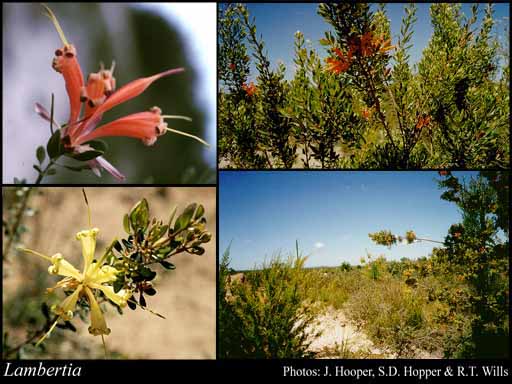- Reference
- Trans.Linn.Soc.London,Bot. 4:214, 223. (1798)
- Name Status
- Current

Scientific Description
Common name. Wild Honeysuckles. Family Proteaceae.
Habit and leaf form. Small trees (bark smooth, rarely fibrous with lenticels), or shrubs; evergreen. To 1–7 m high. Mesophytic, or xerophytic. Heterophyllous, or not heterophyllous. Leaves small to medium-sized; usually whorled, or opposite; (2–)3 per whorl, or 4 per whorl, or 8 per whorl; leathery; petiolate to sessile; edgewise to the stem, or with ‘normal’ orientation; simple; epulvinate. Leaf blades entire (mostly), or dissected; flat; linear, or ovate, or obovate, or oblong, or elliptic, or orbicular; rarely palmately lobed. Mature leaf blades adaxially glabrous, or pilose; abaxially glabrous, or pilose. Leaves without stipules. Leaf blade margins prickly (or spiny), or not prickly. Leaves without a persistent basal meristem. Leaf anatomy. Hairs present, or absent. Stem anatomy. Secondary thickening developing from a conventional cambial ring.
Reproductive type, pollination. Fertile flowers hermaphrodite. Unisexual flowers absent. Plants hermaphrodite. Entomophilous, or ornithophilous.
Inflorescence and flower features. Flowers solitary, or aggregated in ‘inflorescences’. Inflorescence few-flowered, or many-flowered (1–7(-19)-flowered). Inflorescences apparently axillary (on short, lateral shoots), or terminal; with involucral bracts (the bracts sessile). The fruiting inflorescence not conelike. Flowers sessile; small to large; regular to very irregular; when irregular, zygomorphic. The floral asymmetry when present, involving the perianth (the adaxial perianth lobes often arising higher on the tube than the abaxial lobes). Flowers 4 merous; cyclic; tetracyclic. Floral receptacle developing a gynophore, or with neither androphore nor gynophore. Free hypanthium absent. Hypogynous disk present, or absent; extrastaminal; of separate members, or annular (comprising (2-)4 free or fused glands). Perianth of ‘tepals’; 4; 1 -whorled; joined (tubular, but often with 4 free segments from base to 3mm up tube; limb 4-lobed, becoming tightly revolute); hairy, or glabrous; green, or yellow, or orange, or red, or pink. Androecium 4. Androecial members adnate; all equal; free of one another; 1 -whorled. Stamens 4; isomerous with the perianth; filantherous, or with sessile anthers. Anthers basifixed; non-versatile; dehiscing via longitudinal slits; introrse; four locular; tetrasporangiate; appendaged (with an apical gland), or unappendaged. Gynoecium 1 carpelled. The pistil 1 celled. Gynoecium monomerous; of one carpel; superior. Carpel stylate; apically stigmatic. Style with slightly swollen pollen presenter. Carpel 2 ovuled. Placentation marginal, or apical. Styles becoming exserted; hairy, or hairless. Ovules funicled, or sessile; pendulous; non-arillate; orthotropous to hemianatropous.
Fruit and seed features. Fruit subsessile to sessile; persistent; non-fleshy (woody or leathery). The fruiting carpel dehiscent (splitting when seeds ripe); a follicle (smooth or spiny especially along suture, with stylar beak and a pair of prominent horns at distal end of suture). Fruit (1–)2 seeded. Seeds non-endospermic; compressed (or slightly domed on one side); winged. Seed wings encircling body. Embryo well differentiated. Cotyledons 2(–8). Embryo straight. Testa finely papillate.
Special features. Stamens inserted near the end of a perianth segment but not in a concavity, the segment spirally revolute and enclosing the anther at anthesis.
Geography, cytology, number of species. Native of Australia. Endemic to Australia. Australian states and territories: Western Australia and New South Wales. South-West Botanical Province. N=14.
Etymology. After Aylmer Bourke Lambert (1761–1842), English patron of botany, collected and grew many, including Australian, species; his herbarium was second only to that of Sir Joseph Banks in size and quality.